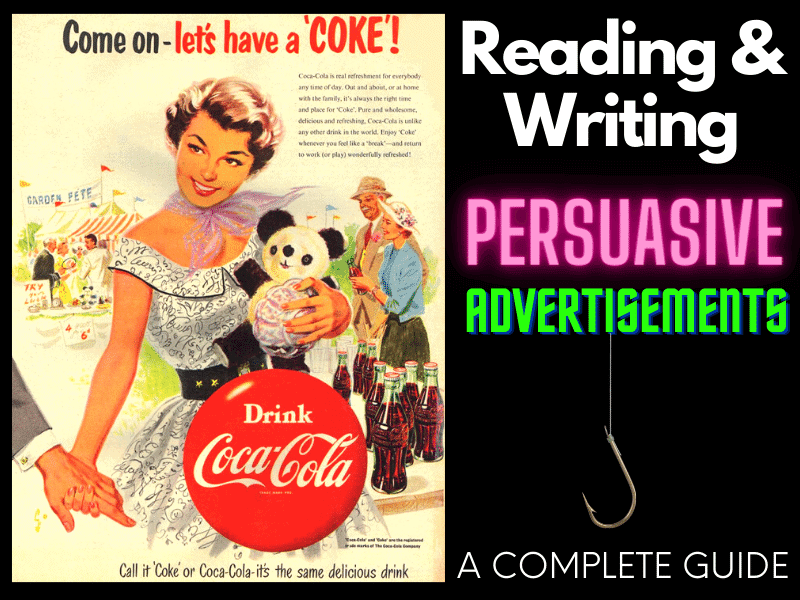

As with persuasive texts in general, advertisements can take many forms – from billboards and radio jingles to movie trailers and pop-ups on your computer.
In this guide, we’ll work towards writing a standard magazine-format advertisement known as the print ad. Print ads are text-heavy enough to provide something meaty for our students to get their teeth into. Though advertisers are increasingly overlooking print ads in favor of more trackable and often cheaper digital forms of advertising, the same strategies and techniques can apply to both.
Likewise, strategies such as emotive language and other persuasive devices are essential when writing ads. Much of the writing advice that follows applies to the other persuasive texts, which can also be found on our site. Be sure to check it out, also.
Let’s explore the structure and persuasive elements that make an advertisement successful. These elements combine to make us think and act favourably about a service or product. So let’s get into it and learn how to write an advertisement.
A COMPLETE UNIT ON ADVERTISING FOR TEACHERS & STUDENTS
Teach your students essential MEDIA LITERACY SKILLS with this COMPLETE UNIT on ADVERTISING. It’s packed with ENGAGING, INFORMATIVE & FUN activities to teach students the persuasive techniques to READ ADVERTS and the skills to WRITE ADVERTS.
This COMPLETE UNIT OF WORK will take your students from zero to hero over FIVE STRATEGIC LESSONS covered.
- WHAT IS ADVERTISING?
- PERSUASIVE TECHNIQUES in advertising.
- How is VISUAL IMAGERY used in advertising?
- The CRAFT of COPYWRITING in advertising.
- How to CREATE YOUR OWN ADVERTISEMENTS.
- How to apply PROVEN MARKETING STRATEGIES.
- and MUCH MORE.
PERSUASIVE TECHNIQUES TUTORIAL VIDEO (2:20)
STRUCTURE AND FEATURES OF ADVERTISEMENTS (PERSUASIVE ELEMENTS)
For students to create their own advertisements and successfully employ the various persuasive techniques, they’ll first need to develop a clear understanding of an advertisement’s underlying structure. We’ll explore the primary structural elements and features of advertisements, though the order of how these appear varies from advert to advert. Here, we’ll take a look at the following persuasive text elements.
- Brand Name
- Audience
- The Image
- Logo
- Call to Action
- The Offer
- Headline
- Slogan
- Body Copy

THE BRAND NAME AS A PERSUASIVE ELEMENT

The brand name of the product or service frequently comes at the top of the advertisement – though not always. One of the first tasks for students when writing their own advertisement is to decide on a name for their product or service.
Please encourage students to select a name that reflects the product, service, or values they wish to present to their audience.
Brand names have evolved from being wordy and aspirational to very short and snappy since the inception of the internet, so they can be found easily on a search engine.
BRAND NAME CONSIDERATIONS
- What are the names of similar already existing products or services?
- Does the name look and sound good?
- Is the name short, punchy, and memorable?
- Does it evoke a feeling or an idea?
- Is it distinctive and original?
THE AUDIENCE AS A PERSUASIVE ELEMENT

An advertisement’s target audience may not always be immediately apparent and often needs to be inferred through language and imagery choices made by the writer.
However, who the target audience does need to be decided before writing as it will inform subsequent choices on the use of language (e.g. pronouns, tone, etc.) and imagery.
There are several ways to help students determine their target audience. A good starting place is for them to consider creating a target persona, a fictional character who represents the type of person their product or service is aimed at.
- Age
- Gender
- Location
- Hobbies
- Income
- Education level
- Occupation
- Marital status
- Likes/Dislikes
- Who they trust
- What they read/watch
An effective print advertisement presents a product or service in an appealing manner. It quickly conveys essential information about that product or service. It will include a clear and specific offer and also provide the information required for the reader to act on that offer.
Once we have the brand name sorted and the audience defined, it’s time to look at the critical structural elements to consider when writing an ad. It’s important to note that not every element will be used in every ad, but the following model serves well for writing most print advertisements.
THE HEADLINE AS A PERSUASIVE ELEMENT
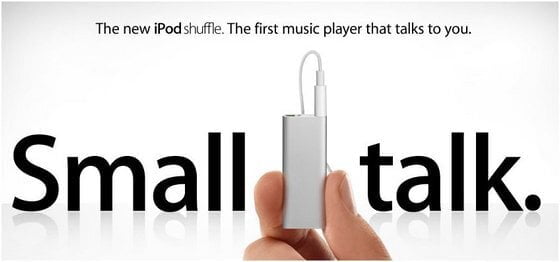
The ad headline should provide a short, snappy preview of what the reader will find in the copy. A good headline grabs the potential customer’s attention and makes them want to read the rest of the ad. There are several tried and tested means of writing a good headline. Here are 3 of the most effective:
The Problem/Solution Headline – This headline details a problem a potential customer may be facing and offers the solution in the form of the product or service. For example: Tired? Sluggish? Overweight? Excero Bike Gets You Where You Need to Go, Fast!
The Testimonial Headline – This headline uses a quote from a customer’s positive review to help sell the product or service. The testimonial allows the potential customer to see some ‘proof’ upfront before buying. “With the Excero Bike, I lost 15lbs in 15 days. I’m now thinner, fitter, and much, much happier!”
The Question Headline – This headline asks a question that the target customer will be seeking an answer to, for example, “Are you paying too much for your x?” Are You Paying Too Much for Your Gym Membership?
THE LOGO AS A PERSUASIVE ELEMENT
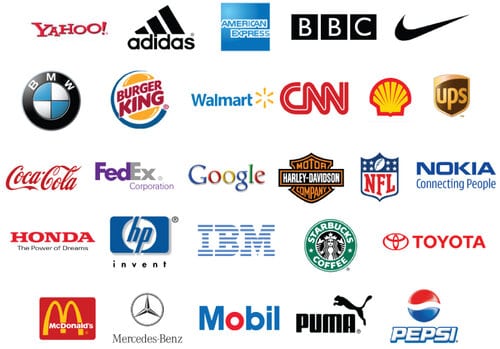
Logos are visual representations of a brand and are used to help promote a range of products and services under a single umbrella and also to allow for quick identification by the reader. They are more of a design element than a writing one.
THE SLOGAN AS A PERSUASIVE ELEMENT
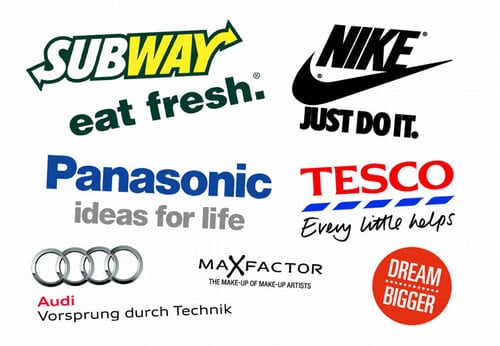
A slogan is a phrase or a short sentence used to represent or sell a particular brand. Usually, they’re designed to be short and snappy to help make them more memorable for readers. Slogans often use alliteration, rhyme, puns, or other figurative language techniques to make their message more memorable.
THE OFFER AS A PERSUASIVE ELEMENT

A good print ad makes readers an offer. This is usually in the form of a benefit the potential customer will gain or a motivating reason for finding out more about the product or service.
The Offer acts as a ‘hook’ that maintains the reader’s focus and draws them into the body of the ad. It can take the form of a time-limited discount or a 2-for-1 offer, etc. This Week Only – 25% Off!
Offers can also form part of the Call to Action at the end of the ad – more details on this soon.
THE BODY COPY AS A PERSUASIVE ELEMENT
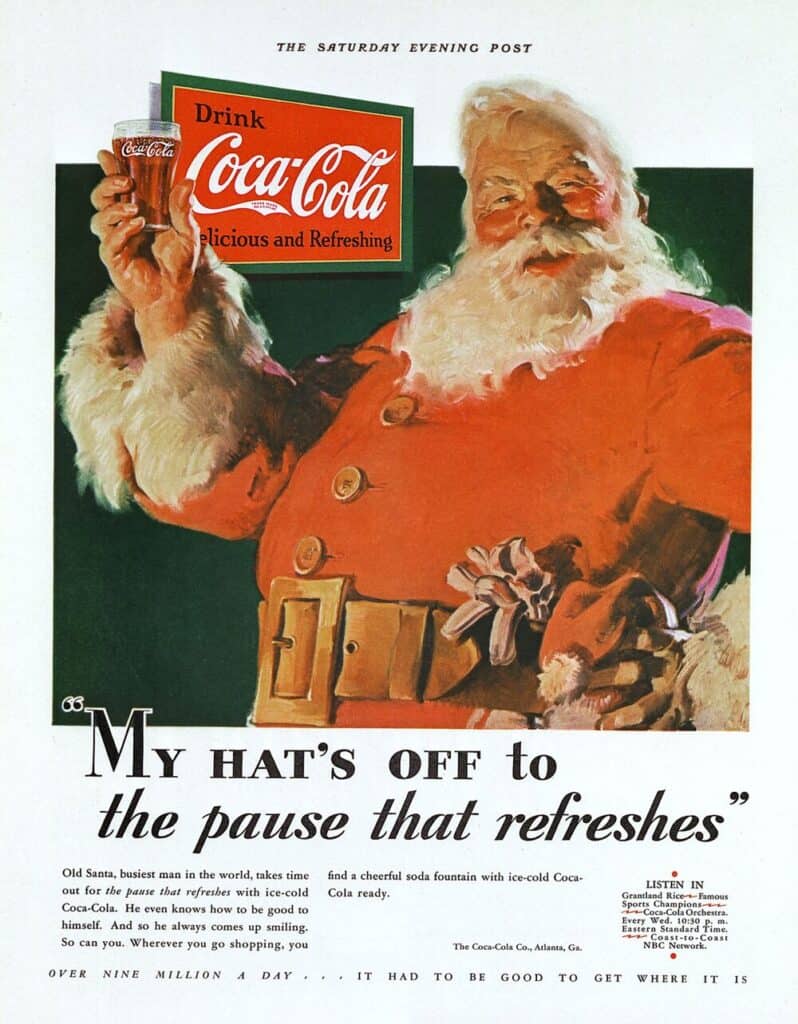
Good body text (or body copy) in an ad is well-organized and quickly gets to the point. Readers want to get the necessary information with minimum effort. For the writer, this requires skill, patience, and much editing. There are several different types of body copy that students need to consider when writing their ads. Let’s take a look at 5 of these:
Factual – Factual copy gives the reader just enough factual information about the product or service to persuade them that it’s worth buying.
Humor – Using humor is a tried-and-tested means of making an ad memorable. To use it successfully, students will need to have an excellent understanding of their target audience.
Narrative – This copy tells a story as a way to draw the customer in. Many people are resistant to direct selling. Narrative copy uses the power of storytelling to build a connection with the customer to ‘soft sell’ to them.
Testimonial – While testimonial content usually comes from a customer, it can also come from experts, celebrities, or any kind of spokesperson. The testimonial is based on what the customer or spokesperson liked about the product or service. Testimonials are often woven into the humanity of the ad. This copy appeals to emotions. Rather than boasting directly of the benefits of the product or service, this type of ad evokes the senses and appeals to emotions.
The body copy might include details of available products or services, special offers, or specific information the advertiser wants potential customers to know. Subheadings and bullet points can help organize the text and make information easier to find. Texts should be short and easy to read. Walls of text can be off-putting; if the language is too complex, it may turn off potential customers.
THE CALL TO ACTION AS A PERSUASIVE ELEMENT

The Call to Action or CTA frequently comes at the end of the advertisement. It’s usually made up of a few sentences that invite the reader to take a specific action. This action might take the form of buying the product, sharing contact information, or, in the case of an online ad, clicking on a link to find out more about the product or service.
Call to action Contexts:
- An electronics company encouraging readers to buy their new computer
- A helpline requesting readers to call a number
- A political party urging readers to vote for them in an upcoming election
- A travel agent appealing to readers to book
- A travel agent appealing to readers to book their next holiday through them
There are many ways to write a CTA but some effective strategies that are commonly used include:
- Start with strong action words urging the reader to take action, e.g. Join, Discover, Order, Subscribe, Buy, etc.
- Let the reader know precisely what you want them to do.
- Ensure the necessary contact details are included, e.g. address, email, website address, phone numbers, etc.
- Motivate the reader to take action through the use of promotional offers, e.g. Get 50% off or Book your free consultation today!
- Provide a reason to take action by communicating the benefits, e.g. Losing weight, Saving money, Performing better, etc.
- Use numbers to appeal to the reader, e.g. Save 20% on your next video, Now with 33% extra free! etc.
- Make your audience an offer they can’t refuse, e.g. Book Your School Marketing and Promotion Analysis today – No Strings Attached.
- Create a sense of urgency by limiting a special offer in some way, e.g. 25% off for the first 100 customers, Free T-shirt if booked today, Buy 2 get 1 free this month only, etc.
PERSUASIVE DEVICES
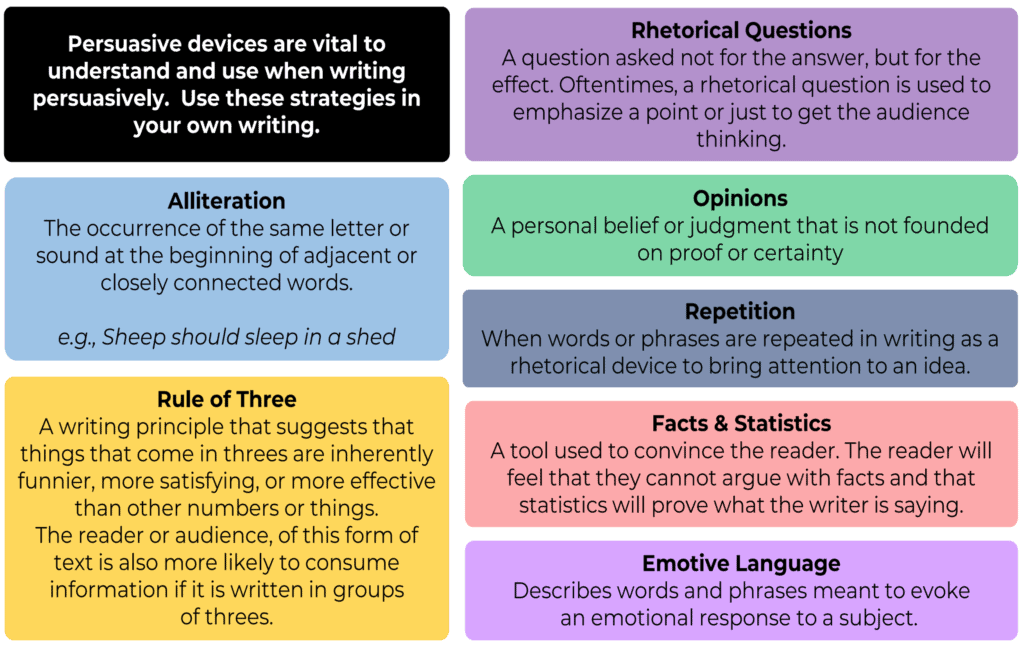
The use of persuasive devices is an essential aspect of writing an advertisement. Our students must clearly understand the following strategies to confidently produce an advertisement that works.
ALLITERATION IN ADVERTISING
This is a literary device that involves the repetition of the initial letter or sound of consecutive words or words near each other. It’s more commonly associated with poetry than nonfiction text types; however, it is also a popular technique used in advertising. Alliteration can help make brand names more memorable. Examples abound, e.g. PayPal, Coca-Cola, Range Rover, and Krispy Kreme, to name but a few.
It’s not just in company names that you’ll find alliteration at work, though. We can also see alliteration alive in slogans such as:
The best four by four by far – Land Rover
Made to make your mouth water – Opal Fruits
Greyhound going great – Greyhound
Don’t dream it. Drive It. – Jaguar
EMOTIVE LANGUAGE
Using emotive language involves deliberately choosing words to provoke an emotional response in the reader. Different ways exist to express the same idea.
We can choose to put a positive, neutral, or negative spin on the same event through the words we select. For example:
Positive: She triumphed gloriously against stiff competition in the spelling bee.
Neutral: She won the spelling bee.
Negative: She received first prize in the poorly attended minor-league spelling bee.
Asking questions can help to engage the reader and persuade them to come to the desired conclusion by themselves. This is the ad equivalent of the ‘show, don’t tell’ mantra employed by fiction writers.
As with all the techniques and strategies, this technique must be used with care. It can have the opposite of the desired effect, such as building resistance in the reader, if used carelessly. Students should avoid making hyperbolic suggestions with their rhetorical questions. For example, the question “Want to lose 50lbs in 2 weeks?” implies a highly exaggerated claim that most intelligent readers will not believe. In this instance, the rhetorical question detracts from the ad’s effectiveness rather than enhances it.
The most important thing for students to remember when using this technique is that they should only ask rhetorical questions in their ads when they can predict with a reasonable degree of certainty what the answer will be in the reader’s mind. Nine times out of ten, that answer should be a simple yes. Questions should be straightforward, as should the answers they generate.
REPETITION
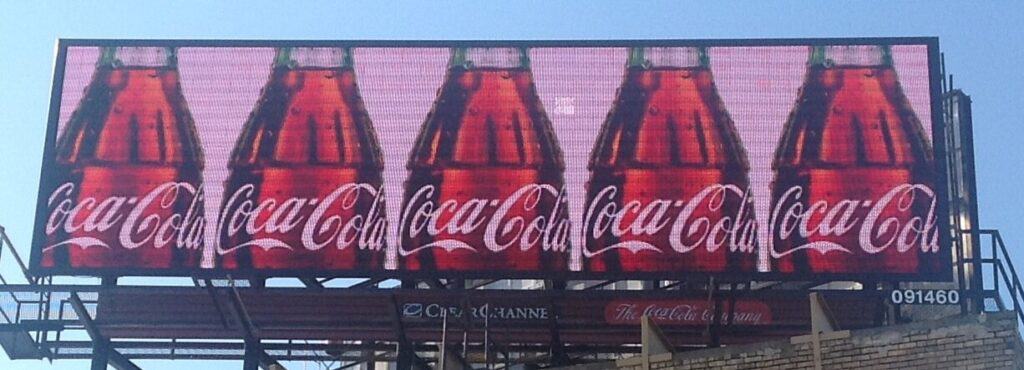
Advertisers know that we usually need to see or hear things several times before we’ll remember them. Also, the reader is more likely to believe something true the more frequently they hear it. For these reasons, advertisements rely heavily on repetition to drive their message home.
In advertising, the repetition of certain keywords or phrases is used to emphasize a specific idea or emotion. When used well, it can increase the overall effectiveness of an ad. However, students should be careful not to bore the reader. Repetition should always be used strategically.
Repetition doesn’t just involve the repeating of words. It can also include repeating colors and images.
Here are some examples of repetition at work.
ADVERTISING WRITING TIPS FOR STUDENTS
- Carefully Consider the recount TYPE and AUDIENCE before writing.
- Keep the title simple, e.g. My First Day at High School
- Organize the text using paragraphs, e.g. a new paragraph for each section. Use the first orientation paragraph to set the scene by introducing characters, setting, and context.
- Write the recount in chronological order – the order in which things happened and keep it in the past tense – relating events that have already happened.
- Choose the correct perspective from which to write the recount, e.g. personal recounts will be told from a first-person perspective (e.g. I, me, etc.). Factual recounts are most often told from the third-person perspective (e.g. she, he, they, etc.).
- Use time connectives to help organize the text and link the different sections of the recount together.
- Avoid repetitive use of language like then x, then y, and then z.”
- Aim to draw the reader into the action by using descriptive and figurative language
- Focus on the most critical/exciting parts.
- Use plenty of detail but ensure it is relevant to the purpose of the recount.
PERSUASIVE VOCABULARY
Vocabulary can elicit an emotional response beyond the literal meaning of the words used. When students understand this, they understand a powerful tool of persuasion.
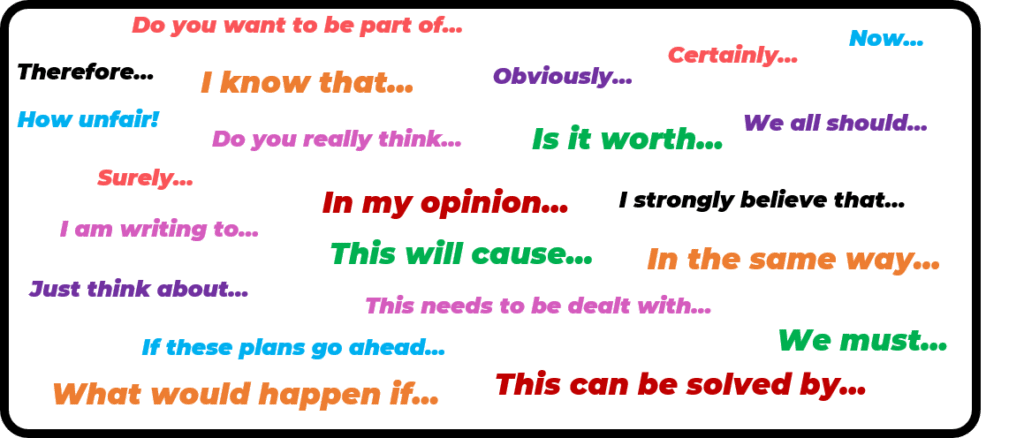
PERSUASIVE ADVERTISING STRATEGIES

The Pain Solution: Persuades by highlighting a problem and suggesting a solution.
The Bandwagon: Persuades to do, think, or buy something because it is popular or because “everyone” is doing it.
The Testimonial: Persuades by using a previous customer or famous person to endorse a product or idea.
The Logical Appeal: Persuades by using reason, usually in the form of a claim backed by supporting evidence.
The Emotional Appeal: Persuades using words that appeal to emotions instead of logic or reason.
The Youth Appeal: Persuades by suggesting you’ll feel younger and more energetic using this product or service.
The Romantic Appeal: Persuades the reader by invoking the powerful and inspiring feelings of love.
The Empathy Appeal: Persuades the reader by encouraging them to identify with the plight of another.
The Testimonial: Persuades the reader by using a previous customer or famous person to endorse a product or idea
THE ROLE OF IMAGES IN AN ADVERTISEMENT
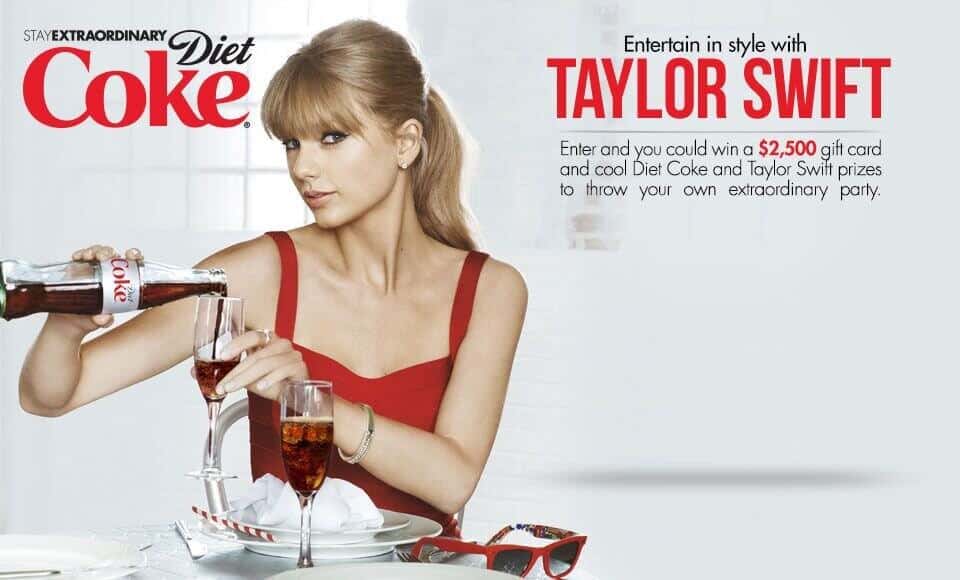
It’s a competitive world out there! Advertisements must catch and hold attention in an overwhelmingly noisy world, and images are a powerful means of doing this. Photos, pictures, diagrams, logos, color schemes – the visual look of an ad is as important as the text and, in some cases, more important!
Interesting images capture interest. They can intrigue the reader and encourage them to read the text they accompany.
Images also help the reader visualize the product or service offered. Advertising space can be expensive, and, as the old adage has it, a picture tells a thousand words. Images help advertisers make the most of their advertising real estate.
Students should carefully choose (or create) images to accompany their text. They should ensure that images are relevant and appropriate for their selling audience. They should look natural and genuine rather than posed.
Students can create their own images using their cell phones or graphic designer apps such as Canva.
This is our complete guide on writing an advertisement for students, and be sure to browse all our persuasive articles whilst you are here. Finally, we also have a complete unit of work on advertising for students and teachers that can be found here.
PERSUASIVE DEVICES TUTORIAL VIDEO
OTHER ARTICLES RELATED TO HOW TO WRITE AN ADVERTISEMENT
The content for this page has been written by Shane Mac Donnchaidh. A former principal of an international school and English university lecturer with 15 years of teaching and administration experience. Shane’s latest Book, The Complete Guide to Nonfiction Writing, can be found here. Editing and support for this article have been provided by the literacyideas team.
Download Article
Download Article
If you’re in business you know that to attract customers and get results, you have to advertise. A great ad attracts attention, generates interest in your product, and leaves consumers with a strong desire to buy it. See Step 1 and beyond to learn the tenets of writing a compelling and effective ad.
-
1
Decide where to publish the ad. Will your advertisement be printed in the newspaper, a magazine, your website, or Facebook? Knowing where you plan to publish the ad will influence the way you write your copy. Find out the perimeters of your advertising space, including how many words you’re allotted, how large the font size will be, and whether you can incorporate graphics or video. Ultimately, the traditional classifieds-style ad will fly in almost any medium, but you might need to make small tweaks to tailor it to the space in which you’re advertising.[1]
- If you’re taking out a quarter to full-page advertisement in your local newspaper, you’re going to have some room to play around with a paragraph or so of copy.
- However, for a Facebook or other online ad, your copy will be limited to a sentence or so.
- Either way, when you’re writing an ad, every word counts. Being too vague or wordy will cause people to skim your advertisement instead of pausing to read it, so the same writing tenets apply no matter what type of ad you’re writing.
-
2
Tailor it to your audience. Which consumers are you targeting? Ideally, everyone who reads your ad will want to buy your product, but in reality you’ll have better results if you tailor your ad to a specific audience that is likely to be more interested than the rest of the world. Use language and references that appeal to the demographic to which your product appeals. It might be a turnoff for other groups of people, but it’s important to speak to the hearts of the people who have the potential to become loyal customers.[2]
- For example, if you’re selling a service that allows people to self publish their books, you’ll want to use language that sounds writerly and elegant. That way your target audience — people who have written books they want to publish — will know they would be in good hands with your company.
- If you’re selling a product that appeals to a younger crowd, like a new type of candy that makes your mouth turn rainbow colors, lose the formality and use language that’s familiar to your target audience — kids who want to spend their allowance on candy, or who could influence their parents to buy the candy for them.
Advertisement
-
3
Write an attention-grabbing headline. This is the most important part of your advertisement, because it’s your one shot at getting consumers to actually read your ad. If your headline is vague, difficult to understand or in any way uninteresting, you can’t expect people to take the time to read the rest of your carefully-written ad. You’re immediately telling them that your company isn’t innovative enough to come up with a compelling ad — which will reflect poorly on your product as well, even if it’s excellent.[3]
- People riding the subway, scrolling through Facebook or flipping through a magazine have hundreds of little pulls on their attention. How can you cut through all the noise and make them focus on your product? Think of a headline so compelling that it essentially forces the person reading it to pay attention.
- Your headline could be something shocking, strange, emotionally compelling, or exciting — it doesn’t matter, as long as it grabs the reader. For example,
- Write something mysterious: Don’t be happy, be terrified.
- Write something people can’t pass up: Get 75% off a ticket to Paris.
- Write something emotional: She has 2 weeks to live.
-
4
Don’t start with a question. You might be able to get away with a highly creative and compelling rhetorical question, but stay away from your standard «Do you need a new car?» type of opener. Consumers have already read thousands of similar questions, and they’re tired of being asked. You’ll have to dig a little deeper to capture their attention. Find a creative way to tell people that you have what they need without asking an obvious question.
-
5
Write a bridge to keep them reading. The next line after your headline is your short, sweet chance to create a solid impression of your company in the minds of your audience. After your mysterious/shocking/emotional headline, you need to follow up with something substantive — otherwise, your headline will be perceived as mere hype.[4]
Use the bridge to tell the consumer what need your product can fill.- Remember that every word counts. Your bridge language needs to be just as compelling as your headline, because there’s still a good chance you could lose people before they get to the end of your ad.
- Touch on the major benefits your product will bring the consumer.[5]
Your bridge should contain your strongest selling points.
-
6
Create desire for your product. Your bridge also serves as a chance to create a strong desire for your product. It’s a chance to play with your audience’s emotions and make them feel as though your product will fill a need they have. If this sounds manipulative, it is — but if you’re offering a product that will actually be helpful to people, there’s no shame in writing copy that tugs on the heartstrings to get people to buy a product that will improve their lives.
- Nostalgia can be an effective tool to capture people’s hearts. For example, We use the finest heirloom peppers to make hot sauce as good as Grandpa’s secret recipe.
- Playing to people’s health concerns can also work well: You’re doing the hard work — quitting. Let us help you get your life back.
- Don’t forget to include the name of your company and your product somewhere in your copy.
-
7
Tell them how to get your product. Finally, write a strong ending that tells your audience exactly what to do next. Give them an action to take that makes it easy for them to buy your product or get in touch.
- It’s common for ads to include a straightforward directive, like Call 555-5555 for more information.
- You could also just list your website, and people will know to go there to buy your product.
Advertisement
-
1
Dissect bad ads. When you’re new to writing ads, it can help to break down other ads and figure out where they went wrong. Find a few bad ads — you’ll know they’re bad because your first impulse will be to skim right over them — and try to figure out what makes them so ineffective. Is it the headline? The bridge? The tone?
- Once you’ve pinpointed what makes the ad bad, think about how you could make it better. Rewrite the ad to make it more effective.
- Take a look at effective ads, too, and try to determine what makes them great.
-
2
Make it sound natural. When you write your own ad, try to make it sound as natural as you can. Write it as though you’re saying it to someone else. People are drawn to natural writing — it speaks to them in a way that overly formal, stilted writing just doesn’t.[6]
- Don’t be too stiff — you want your audience to feel accepted and understood.
- Don’t be too friendly, either — you could come off sounding fake.
-
3
Keep it brief. No matter where your ad is published, you should keep it short and sweet. People don’t have time to read an ad that requires more than about 30 seconds of their attention — or less. They’re encountering your ad on their way to doing something else, like reading an article or getting off the train or bus they’re riding. Your ad should be interesting enough to make a big impression using very few words.[7]
- Since your ad will be short, make it very specific. Don’t use vague language and get to the point right away.
- Use short sentences instead of long ones. Longer sentences are difficult to take in in a short period of time.
- Play with your copy so that you say what you want to say in as few words as possible. It’s not necessary to use complete sentences, as long as your message gets across clearly.
-
4
Consider using testimonials. These days, people want to read reviews and testimonials before buying a product. They aren’t usually content to try it out until they’re reasonably sure that it has worked for other people. Incorporating a testimonial or two into your ad could be a great way to build trust with your audience right off the bat.
- Choose a quote from a well-respected customer, if possible. For example, if you’re selling a health product, use a quote from a doctor or another health professional.
- If you’re short on space, you can always put testimonials on your website instead of using them in your ad.
-
5
Use graphics wisely. If you have the opportunity to use an image or video in your advertisement, think carefully about your ad’s composition. Having an image will allow you to use fewer words — you won’t necessarily need to describe your product’s features or state what it does. Instead, Juxtapose the picture or video with an intriguing headline or tagline and your company’s URL.
- The image or video you choose is just as important as the copy you write — if not more important. Choose graphics that compel your readers on an emotional level and make them desire your product.
-
6
Record yourself saying it aloud. Once you have your ad written, record yourself reading it or saying it to someone. Play it back to yourself. Does it sound conversational? Is it compelling? If someone said it to you, would your interest be piqued? Reading it out loud is a good way to spot deficiencies that could cause your ad to fall flat.
-
7
Test your ad. Go ahead and publish it in a few places to see what kind of reception it gets. Hopefully, you’ll see your sales start to increase. You can determine whether new business is a direct result of your ad by asking customers how they heard about your company. If they reference your ad, you know it’s working![8]
-
8
Rewrite it until it works. Don’t keep publishing an ad that isn’t increasing your sales. Keep rewriting it until you’re confident it’s actually bringing in more business. A poorly-written ad that doesn’t represent your company well can actually do more harm than good. After you’ve used your ad for a few months, keep things fresh by rewriting it to advertise a new product or feature.
Advertisement
Annotated Advertisements
Add New Question
-
Question
Which online advertising is best?
Emily Hickey, MS
Marketing Consultant & Master’s Degree, Business, Stanford University
Emily Hickey is the Founder of Chief Detective, a social media growth agency that helps some of the world’s top retailers and start-ups scale their Facebook and Instagram advertising. She has worked as a growth expert for over 20 years and received her Master’s from the Stanford Graduate School of Business in 2006.
Marketing Consultant & Master’s Degree, Business, Stanford University
Expert Answer
Social media is really becoming video-first, particularly on Facebook and Instagram, and creating a video doesn’t have to be complicated. You can even just take your product imagery and cobble it into a video montage with text overlays.
-
Question
Can you give tips on the techniques for using persuasive language in ads?
Try to use imperatives. These are verbs which tell someone to do something. Be mindful of how it sounds. If it helps, read the sentence out. This is because you do not want to appear to forceful as if you do it can put people off and make you seem overly aggressive or pushy.
-
Question
How should I write an advertisement for Nandini milk?
You can write anything as long as it’s associated with the product. Some ideas are: Where does it come from? What is so great about it? You want to write something appealing or interesting about the product so more people will buy it.
See more answers
Ask a Question
200 characters left
Include your email address to get a message when this question is answered.
Submit
Advertisement
-
Keep a swipe-file of ads of similar products or businesses. Also cut out ads that you like. Both types of ads can assist you with ideas.
-
Providing specific detail makes the ad a bit delightful, and starting or ending with thoughtful and creative thoughts is a better way to go.
-
Advertisement for nurses recruitment both men and woman with qualification, skills, time,date and venue for interview.
Advertisement
References
About This Article
Article SummaryX
To write an advertisement, start with a headline that will grab your audience’s attention, like something funny, strange, or emotionally compelling. In the next line after your headline, concisely tell the reader what you’re offering and what the benefits are. Also, use this bridge sentence to create desire for your product, like by invoking nostalgia or playing to people’s health concerns, for example. Finally, include a strong ending that tells people how to get your product or how they can contact you for more information. For tips on how to use testimonials in your ad, keep reading!
Did this summary help you?
Thanks to all authors for creating a page that has been read 489,310 times.
Reader Success Stories
-
«I was doing a research on how to advertise a job vacancy, and the information here is on point and really helpful!…» more
Did this article help you?
For an advertisement to be effective, it should be able to catch the readers’ attention, keep them curious for more, and lead them to buy the advertised product. You can write effective ads by following these five short tips.
-
1. Use Short Sentences
Long sentences will not sell your ad, let alone your product. People’s attention span tends to drift fast these days, so don’t bore your readers with long sentences. Instead, be direct and to the point.
-
2. Use Different Sentence Structures
Do not be afraid to be creative in your writing. Employ different sentence structures within your ad to keep your readers interested. The more varied your presentation is, the less boring your ad becomes.
-
3. Keep Your Ad Short
You don’t have to cram all the information you have into your ad. On the other hand, your ad should make your readers curious and leave them wanting more. Short ads will accomplish this for you.
-
4. Close With a Statement That Calls Your Reader to Action
If the opening statement needs to catch attention, the closing statement should call your readers to action. It should be written creatively enough so that the readers will be interested to know more about your product and buy it.
-
5. Re-Read and Rewrite as Necessary
After you have written your ad, read it again. Proofread your writing and rewrite as necessary. The proofreading stage is just as important as the writing stage because having errors in your ad easily destroys your credibility. Most people ignore ads that have grammatical errors. If you are not an expert in English proofreading and editing, then you can employ the help of English editing software.
Related Articles
- Common Mistakes Made in Emails
- 5 Tips for Writing the Perfect Sales Pitch
- How to Write a Business Email
- Business English Resources
- Positive Business Writing Techniques
- 4 Tips for Correct Use of the Comma
Here are important things to remember about the advertising format of commercial advertisement writing:
- Use a catchy headline.
- Bold out the offers.
- Use Alliteration or metaphors.
- Proportional fonts.
- Give name, contact and other details.
- Put the advertisement in a box.
Considering this, What are the 4 types of advertising? What are the 4 types of Advertising
- Display Advertising.
- Video Advertising.
- Mobile Advertising.
- Native Advertising.
What is the first step to create an advertisement? Here’s a guide to mastering the process:
- Choose your target audience. …
- Conduct market research. …
- Choose your platform and ad format. …
- Decide whether you’re building brand awareness or product awareness. …
- Craft a memorable message. …
- Gather creative assets. …
- Create custom videos. …
- Use striking visuals.
Furthermore, How do you write a missing ad? Advertisement Writing on Missing Persons Format
- Must have the title – ‘MISSING’ in capital letters.
- Must include the name, age or health related issues (if any)
- Must include the description of the person.
- Birth mark or any other identification mark can be included.
- Must include the place where the person was last seen.
What are the 11 types of advertising?
11 types of marketing
- Advertising.
- Content marketing.
- Search engine marketing.
- Social media marketing.
- Call-to-action marketing.
- Direct marketing.
- Account-based marketing.
- Guerilla marketing.
What are the 3 types of ads? What types of Airworthiness Directives ( ADs ) are issued?
- Notice of Proposed Rulemaking ( NPRM ), followed by a Final Rule.
- Final Rule; Request for Comments.
- Emergency ADs.
What are the best types of ads? Here are some of the best types of advertising used by small businesses to promote a product, service or content:
- Social Media Advertising. …
- Pay-Per-Click Advertising. …
- Mobile Advertising. …
- Print Advertising. …
- Broadcast Advertising. …
- Out-of-Home Advertising. …
- Direct Mail Advertising.
How do I make an advertisement poster? How To Design a Poster From Scratch
- Identify the goal of your poster.
- Consider your target audience.
- Decide where you want to share your poster.
- Select a pre-made poster template.
- Pick a relevant or branded color scheme.
- Include a clear call to action.
- Use varied fonts to create visual hierarchy.
How do I make a picture ad?
What can I advertise for a project? 40 free advertising ideas that are sneaky but brilliant
- Claim any existing profiles or listings. …
- Find other opportunities to get listed. …
- Make a free advertising video with Biteable. …
- Google your business. …
- Join the conversation. …
- Comment on blogs and articles. …
- Start blogging. …
- Host and/or participate in Twitter chats.
How do I write a class 10 ad?
i) Begin your advertisement with the heading- LOST AND FOUND or LOST LOST. ii) Write down the description of the item that has been lost. v) End with the contact number and name of the writer.
How do I write a newspaper ad? A Few Basic Pointers on Writing Your Own Newspaper Ad
- Headline. Get readers’ attention with a headline or an eye-catching phrase. …
- Copy Length. Use a copy length that supports your message. …
- Comparison. …
- Benefits. …
- Closing. …
- The Biggest Waste. …
- Newspaper Advertising Doesn’t Always Work For Small Businesses. …
- Product Ad Dilemma.
What are the 5 advertising techniques?
So here are some very common and most used techniques used by the advertisers to get desired results.
- Emotional Appeal. …
- Promotional Advertising. …
- Bandwagon Advertising. …
- Facts and Statistics. …
- Unfinished Ads. …
- Weasel Words. …
- Endorsements. …
- Complementing the Customers.
What are the four rules for good advertising?
Quality Beats Quantity
- Rule # 1: Find someone who knows how to build an effective advertising campaign. …
- Rule # 2: Find the right message and don’t get too caught up in art or subtlety. …
- Rule # 3: Repetition, repetition, repetition. …
- Rule # 4: Be focused and disciplined in your placement.
What are the 2 types of advertising? Lesson Summary
Institutional and product are the two main types of advertising. Institutional is a type of advertising that is used to improve a company’s image instead of promoting an individual product. Product advertising promotes the product or service to the target market by focusing on the benefits.
What are the 4 objectives of advertising? Objectives of Advertising – Preparing Ground for New Product, Creation of Demand, Facing the Competition, Creating Goodwill, Barring New Entrants and a Few Others.
How can I advertise cheap and effectively?
11 cheap or free advertising methods
- Build a company website. It may seem like common sense, but your business needs a website to be competitive online. …
- Online advertising. …
- Use search engine optimisation. …
- Content marketing. …
- Use social networks. …
- Share video content online. …
- Share photos online. …
- Use pay-per-click advertising.
What is the cheapest way of advertising? The cheapest way to advertise is social media ads and classified ads, generally speaking. These kinds of ads can be placed starting as little as $20.
How do you make a good advertisement?
Here are some guidelines for creating memorable advertising that really sells:
- Make sure your ads are “on strategy” with your business positioning. …
- Communicate a simple, single message. …
- Stick with a likable style. …
- Be credible. …
- Ask for the sale. …
- Make sure the ad is competitive. …
- Make sure the ad looks professional.
How do you design a template? Click a template that is similar to the one that you want to create, and then click Choose. Add, delete, or change any text, graphics, or formatting, and make any other changes that you want to appear in all new documents that you base on the template. On the File menu, click Save As.
How can I make a good poster?
What Makes a Good Poster?
- Important information should be readable from about 10 feet away.
- Title is short and draws interest.
- Word count of about 300 to 800 words.
- Text is clear and to the point.
- Use of bullets, numbering, and headlines make it easy to read.
- Effective use of graphics, color and fonts.
Join our Advertising Community and share you ideas today !
One of the things you’ll be doing, once you’ve established a presence on the web, is writing advertisements for your site. Online advertisements, or online marketing in general, is important for any brand for it to flourish and reach the awareness of people.
Each time you list your site on a Free For All Links page, a Free Classifieds site or with a search engine, you’ll be required to enter what is, in fact, an ad. It pays to keep in mind that even though this might be called a “description”, it’s the first thing people will see about your site – so make sure you direct it to them.
Here are some tips on writing advertisements:
How To Write A Good Advertisement
Think Of Your Brand And Audience
Is your brand youthful, or more on the formal side? Is your target audience young professionals or retirees or something in between? You need to determine this first before writing advertisements, so that your ad can resonate with your target audience easily.
What’s In It For The Customers?
As with all advertising, this is what people are interested in. How can your gizmo can improve their life? How can they benefit from it? Mind, not the benefits it will bring to humanity or the environment, but “what’s in it for me?” Because of this, you should remember:
- Your opening words, then, must tell people how they will benefit from visiting your site.
- You must also give people a brief idea about the nature of your site. What specific product or service is it selling? Does it offer a free product or service that can attract customers? What can people expect to find at your site? These are the first things people will look for.
The Heading
On the web, there isn’t time for cute headings – people want information and they want it now! So you need to let your readers know exactly what you’re offering in your heading.
Your heading should be no more than four or five words – the fewer the better. This heading should immediately catch the customers’ attention; or else, they will just ignore it.
For example:
- Free Software
- Beautiful Web Design
- Improve Your Writing
- A Joke A Day
- Learn HTML Easily
- Relieve Your Pain Fast
Words That Appeal When Writing Advertisements
There are a number of words which have been shown to appeal to readers, some of these are:
- Free
- New
- Proven
- Secret
- Success
- Instant
- Fast
- Simple
- How to
- Save
- Easy
- Limited time only
Always try to include at least a couple of these words in your ad.
Personal Pronouns
We’re all most interested in ourselves, so direct all your comments to you, the reader. Use you, your, yours wherever possible.
Include we, our, ours throughout your ad, but use I, me, mine very sparingly.
Give Us The Facts
- Be exact. Don’t tell us that we’ll make “thousands of dollars” with this scheme, tell us we’ll “see a 20% increase in sales within the first year” – and we’ll be more likely to believe you.
- Use numbers if possible. The title “101 Uses for Plastic Shopping Bags” is more likely to gain our attention, than “Things to do with plastic shopping bags”.
- Don’t use adjectives and adverbs in your ads. These descriptors should be for your poetry and love letters. An ad should contain plenty of verbs – you need to convey a sense of action and urgency if you want people to buy from you.
- Be simple, direct, and concise. You don’t need to use big words and flowery language. Don’t be clever if it means some of your readers won’t understand your ad – a review of Christopher Isherwood’s, “I am a Camera”, was “Me no Leica” – which is clever if you happen to know that a Leica is a camera.
Organisation Of Ideas
When writing advertisements, always keep the consumers in mind. Put yourself in their position and ask yourself, “What would appeal the most to them?” Once you”ve got this, you can start writing. You should always start with the greatest benefit to the reader:
- Expected improvements in finances, health, career, romance, appearance, security, self-esteem
- Removing worry
- Eliminating unpleasant tasks
- Reducing physical, mental or physical pain
- Avoiding risky undertakings
- Introducing new experiences to overcome boredom
End With An Appeal For Action
Always finish your ad by telling your readers what you want them to do. This will create an urgency and fear of missing out (FOMO) feeling in the consumers. Here are some examples you can use:
- Click here for more information
- Act now.
- Only ten remaining vacancies – reply now!
- Forward this to all your friends who need this!
- Order before the end of the month
- Go to our secure order form
- Available for a limited time only.
- Don’t miss out on this great opportunity!
Proofread, proofread, proofread.
This is an important step – as important as writing the advertisement itself. Think of proofreading as a quality assurance procedure. Of course, you would not want a typo-ridden, poorly-written ad to be seen on your site, right? Those kinds of ads will be on the internet forever, especially with memes.
- Before you launch your ad onto the web, re-read it and check for basic mistakes in spelling, punctuation, and expression. We all know how easy it is to read what you meant to write, instead of what’s there on the page.
- Then re-read your ad and check that you’ve used words, which convey benefits to your readers.
- Pay particular attention to your headline.
- Ask someone you trust to read it for you. It might be good enough for you, but it doesn’t hurt to ask for a second opinion.
Keep Copies
This is an important reminder: always keep a copy of your ads. That way, you can just cut and paste, instead of having to re-invent the wheel every time you need to insert a description of your site or place an ad. This will save much of your time you can spend doing other things.
Final Thoughts
Writing advertisements is both an art and science, as you have to balance good writing and persuade the audience to buy your product or service at the same time. But with constant practice, you’ll crack the code and write the ad that will win your audience’s hearts (and wallets). Good luck with your writing!
Don’t forget to use our character counter tool to check the number of characters in your advertisement!
















